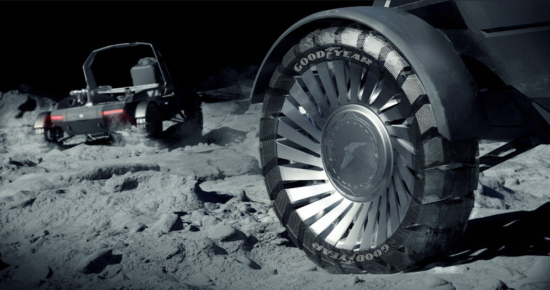Goodyear joins quest to commercialise Lunar mobility
 Within around 3 years, airless tyres may again leave their tracks on the Lunar surface (Image: Goodyear)
Within around 3 years, airless tyres may again leave their tracks on the Lunar surface (Image: Goodyear)
This week marks the 53rd anniversary of Apollo 11 landing on the surface of the Moon, a date of particular significance for The Goodyear Tire & Rubber Company. Goodyear supplied a number of essential components for this history-making mission and later developed non-pneumatic tyres for the Apollo Lunar Roving Vehicle. The tyre maker is once again looking spacewards and is developing tyres for a lunar vehicle that in future may extend commercialism to the Earth’s rocky satellite.
NASA’s Artemis programme is sending humans back to the Moon where they will explore and conduct scientific experiments using a variety of rovers. The space agency sought industry approaches to develop a lunar terrain vehicle that will enable astronauts to explore the surface of the Moon farther than ever before, and in May 2021 Lockheed Martin and General Motors announced their collaboration on a new generation of vehicle. Goodyear is now joining Lockheed Martin to contribute its decades of tyre development expertise. They and the other companies working on the Artemis programme intend to be the first to establish extended-use commercial vehicle operations on the Moon.
NASA one of many customers
“NASA’s Artemis programme to live and work on the Moon has a clear need for lunar surface transportation that we intend to meet with vehicles driven by astronauts or operated autonomously without crew,” says Kirk Shireman, vice president of Lunar Exploration Campaigns at Lockheed Martin. “We’re developing this new generation of lunar mobility vehicle to be available to NASA and for commercial companies and even other space agencies to support science and human exploration. This approach exemplifies NASA’s desire for industry to take the lead with commercial efforts that enable the agency to be one of many customers.”
The starting point for Goodyear’s lunar tyre development is its earthbound airless tyre technology that’s used on micro-mobility, autonomous shuttles and passenger vehicles. The partners are already applying existing expertise to the project including testing concepts in lunar soil test beds. For Goodyear, the programme is a two-way street that will also aid its future development of non-pneumatic tyres for more mundane applications.
“Everything we learn from making tyres for the Moon’s extremely difficult operating environment will help us make better airless tyres on Earth,” comments Chris Helsel, senior vice president, Global Operations and Chief Technology Officer at Goodyear. “This will contribute to our end goal of enabling mobility no matter where it takes place. Just as important, it is an honour to write history with this prestigious company who knows how to make giant leaps in exploration and mobility.”
Extending tyre lifetime & durability
The Apollo lunar rovers of the 1970s were purposely built for just a few days of use on excursions within five miles of their landing sites. Future missions will need to traverse rugged terrain over much longer distances while operating in greater temperature extremes. Goodyear will thus need to develop new tyres capable of lasting years and surviving -140ºC during the Lunar night and around 120ºC in the day.
Lockheed Martin leads this growing team by leveraging its more than 50-year-history of working with NASA on deep space human and robotic spacecraft, such as NASA’s Orion exploration-class spaceship for Artemis and numerous Mars planetary spacecraft. The company will also manage the development of the programme’s commercial business operations and engagement with NASA and global space agencies. Lockheed Martin has also helped NASA explore every planet of our solar system, and continues to develop new technologies for future space missions.
Another participant, MDA of Canada, recently announced its commercial robotic arm technology will be used on the human-rated lunar mobility vehicles. The arm will provide valuable contributions as support for astronauts as well as enabling greater functionality of the rover on fully autonomous missions.
Together, the teams are applying unique perspectives and shared expertise to new challenges and market approaches that are being considered for the first time. The companies expect to have its first vehicle on the surface of the Moon in time to support NASA’s first landed mission that will have the first woman and first person of colour walk on the Moon, currently planned for 2025.





Comments